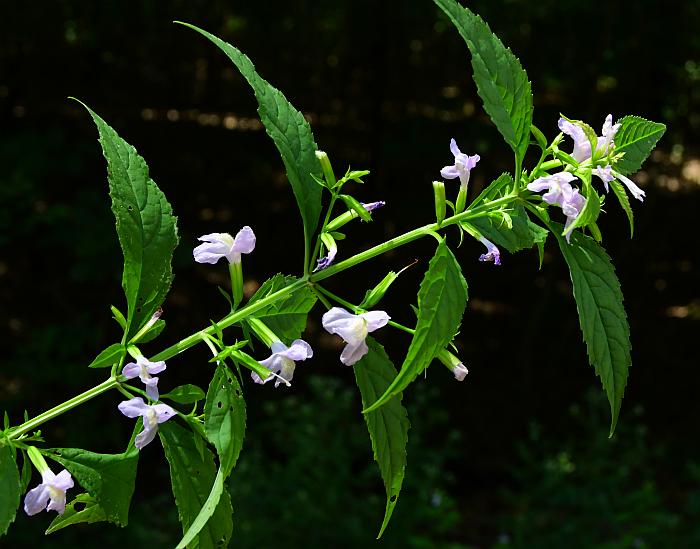Mimulus alatus Aiton
Sharpwing Monkey Flower

Native
CC = 5
CW = -5
MOC = 87
© SRTurner
Mimulus alatus AitonSharpwing Monkey Flower | |
 |
Native CC = 5 CW = -5 MOC = 87 |
© SRTurner |
|
Family - Phrymaceae Habit - Perennial forb with fibrous roots, often also with rhizomes or stolons. Stems - Strongly ascending to erect, to 1.2 m, branching above or simple, 4-angled with the angles mostly narrowly winged, glabrous.
Leaves - Opposite, simple, decussate, petiolate. Petioles 1-2 cm long, sometimes narrowly winged, not clasping the stem. Leaf blades 4-13 cm long (the uppermost often shorter and bractlike), 3-5 times as long as wide, broadly lanceolate to ovate or elliptic-ovate, angled or tapered at the base, tapered to a sharply pointed tip, the margins relatively sharply and finely to coarsely toothed, the surfaces glabrous, the venation pinnate.
Inflorescences - Solitary axillary flowers, or on short axillary branches, the stalks 2-10 mm long, sometimes elongating to 3-17 mm at fruiting.
Flowers - Calyces 11-19 mm long, nearly actinomorphic, narrowly funnelform, the lobes 0.8-2.5 mm long, broadly ovate-triangular to semicircular, the thickened midrib of each sepal often extending past the body of the lobe as a short, stiff, straight awn, glabrous externally. Corollas bilabiate, 20-40 mm long, light blue to pale purple, finely glandular-hairy, the upper lip 2-lobed, usually strongly curved or bent outward, the lower lip 3-lobed, with a pale yellow area toward the base, this usually at least faintly red-spotted, the throat usually appearing more or less closed by the prominent, blunt ridges of the lower lip. Stamens 4, didynamous, adnate at base of corolla tube, included. Filaments white, glabrous, 6-7 mm long. Anthers brownish, 1.3 mm broad. Style included, white, glabrous, 7 mm long. Stigmas 2, flattened. Ovary 2-locular, light green, glabrous, 6 mm long, ovoid-conic. Placentation axile.
Fruits - Capsules 8-12 mm long, ovoid to narrowly ellipsoid-ovoid, glabrous. Seeds 0.3-0.4 mm long, oblong-ellipsoid to ellipsoid-ovoid, the surface with a fine network of ridges, light brown to brown.
Flowering - June - September. Habitat - Streambanks, pond margins, sloughs, oxbows, fens, seeps, swamps, bottomland forests, ditches, wet roadsides. Origin - Native to the U.S. Lookalikes - M. ringens. Other info. - This species is found in moist areas throughout most of Missouri, less commonly in the northwestern quadrant of the state. It is common across most of the eastern half of the continental U.S. Photographs taken off 53rd Terrace, Platte County, MO., 8-17-00, and in the Ozark Scenic Riverways, Shannon County, MO., 8-12-03 (DETenaglia); also at Busch Wildlife Area, St. Charles County, MO, 7-29-2007, 7-31-2009, 7-27-2011, and 7-29-2015, along Fox Creek, St. Louis County, MO, 7-13-2012, at Otter Slough Conservation Area, Stoddard County, MO, 8-15-2021, and Riverfront Park, Washington, Franklin County, MO, 7-10-2025 (SRTurner). |